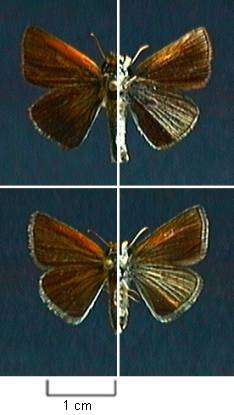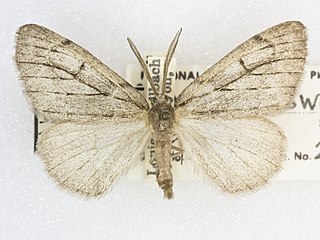
The Cape Verde shearwater, or cagarra locally, is a medium-large shearwater, a seabird in the petrel family Procellariidae. It is endemic to the Cape Verde archipelago of Macaronesia in the Atlantic Ocean, off the coast of West Africa.

Lobsters are widely fished around the world for their meat. They are often hard to catch in large numbers, but their large size can make them a profitable catch. Although the majority of the targeted species are tropical, the majority of the global catch is in temperate waters.

Sistrurus tergeminus edwardsii, also known as the desert massasauga, is a subspecies of venomous pit viper in the family Viperidae. The subspecies is endemic to the Southwestern United States and northern Mexico. In places, its range overlaps that of S. t. tergeminus, and intergrading of the two subspecies is known.

Stenolemus is a genus of thread-legged bug (Emesinae). Species of this genus are noted for preying on spiders.

Oarisma poweshiek, the Poweshiek skipperling, is a North American butterfly in the family Hesperiidae (skippers), subfamily Hesperiinae. The range of this species in Canada is restricted to southeastern Manitoba, and in the United States it historically ranged from the Dakotas to the southern Lower Peninsula of Michigan.

Nemoria darwiniata, the Columbian emerald, is a species of emerald moth in the family Geometridae. It was first described by Harrison Gray Dyar Jr. in 1904 and it is found in North America.

Odontosia elegans, the elegant prominent, is a species of moth in the family Notodontidae. It was first described by Herman Strecker in 1885 and it is found in North America.
Stenoporpia dionaria is a species of moth in the family Geometridae first described by William Barnes and James Halliday McDunnough in 1918. It is found in North America.

Nepytia swetti is a species of moth in the family Geometridae first described by William Barnes and Foster Hendrickson Benjamin in 1923. It is found in North America.

Episemasia cervinaria is a species of geometrid moth in the family Geometridae first described by Alpheus Spring Packard in 1873. It is found in North America.
Melecta edwardsii, or Edward's melectum, is a species of digger-cuckoo bee in the family Apidae. It is found in Central America and North America.
Paracosmus is a genus of bee flies in the family Bombyliidae. There are about five described species in Paracosmus.
Chrysobothris edwardsii is a species of metallic wood-boring beetle in the family Buprestidae. It is found in Central America and North America.
Eucera edwardsii is a species of long-horned bee in the family Apidae. It is found in Central America and North America.
Anarta edwardsii is a species of cutworm or dart moth in the family Noctuidae.
Paracosmus edwardsii is a species of bee flies in the family Bombyliidae.
Eubrianax edwardsii is a species of water penny beetle in the family Psephenidae. It is found in North America.
Eubrianax is a genus of water penny beetles in the family Psephenidae. There are about 12 described species in Eubrianax.
Nomada edwardsii is a species of nomad bee in the family Apidae. It is found in Central America and North America.
Hemipenthes edwardsii is a species of bee flies in the family Bombyliidae.









